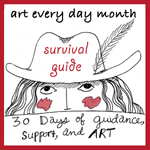Interview with Alexia Vernon, author of Step Into Your Moxie
January 17th, 2019
I was recently given a copy of Step Into Your Moxie by Alexia Vernon. The book was full of great tips on how to step into your truest, most powerful self, so that you can express the things that you are here to share with the world. I liked her tips on how to speak back to the voices in our heads with questions like, "What are other possible options?" and "How is my judgment undermining me?" The way she describes it makes me think of a tool I use, which is to imagine what the nicest mom in the world would say to me as a way to counteract negative self-talk. I hope you enjoy this interview with Alexa and if you want more, check out her book!
What does it mean to “step into your moxie”?
Stepping into your moxie is the ability to walk into any room, or onto any stage, present your ideas, unapologetically, and have them move people to take action. I love the word moxie because it suggests a way of thinking, a way of feeling, and a way of behaving that activates speaking up and disrupting the status quo. This is what Step into Your Moxie is all about — amplifying your voice, visibility, and influence in the world — even if, especially if, you have previously struggled to do so in your work, your community, or in your personal life.
You encourage your readers to identify their go-to filler words and use the practice of “Stop and Smile” to weed them out. Tell us more.
To step into the fullest expression of your moxie, it’s vital to ditch words and phrases that sabotage your influence. Many of these ineffectual words emerge as vocalized thinking, or as filler words, which we speak when we are not exactly sure what to say next. I’m referring to words and phrases like um, so, like, okay, anyway(s), and you know. We use them when our brains and mouths fall out of step, and we need a moment to realign. These are some of the most damaging words to our own (and others’) perception of our moxie, and fortunately, some of the easiest to weed out. Enter the practice of Stop and Smile. When you Stop and Smile, you literally stop what you are saying, even if it’s midsentence. And you smile, and breathe, and make eye contact with whomever you are speaking to (rather than concede to the temptation to double-check that the sky is still blue or that your shoes are scuff-free). Whether you Stop and Smile for a millisecond or for half a minute, you resist the temptation to vocalize your thinking with an um, so, like, okay, anyway(s), or you know, and prioritize connection over verbal communication.
You say it is important to “begin with the end in mind” when devising communication. Can you explain what you mean?
Most of us devise our communication the same way — from the beginning to the end. Spoiler alert: this is the wrong way! Because when you craft your communication linearly, it often does not lead you to your destination — or powerfully move people to take action on your ideas. Whether your goal is to prepare for and master a daring conversation, a negotiation, or a presentation, when you “begin with the end in mind,” you start by asking yourself: What is my call to action? Then, you ask yourself: What does my audience (whether it’s an audience of 1 or 100) need to hear from me right before? And how is this leading them toward my call to action? You answer this question for yourself. And then you keep asking: What does my audience need to hear from me before that? until you work yourself back to the start of what you want to say.
You encourage your readers to stop labeling the sensations they feel in their body during visibility opportunities fear. What do you propose they do instead?
If you are anything like me, or at least who I used to be, my hunch is that when you are on the cusp of doing (and especially saying) something big, important, and paradigm shifting, you label what you are experiencing in your body as fear. However, what you are feeling in these moments is your body acknowledging that you are on the cusp of something important. If you mine your life to uncover the moments when you felt like you busted through your own glass ceiling — when you spoke your truth, negotiated your worth, crushed a sales call, or found the words to have a daring conversation — my hunch is you didn’t feel like you were on a beach vacation. Rather, you felt like a colony of butterflies had migrated for the winter into your thoracic cavity. This is normal. This is you on the brink of stepping into your moxie. And the last thing you want to do is to shove that sensation back down or create a narrative around it that positions you as a victim or martyr rather than as a protagonist — which is what you are. If you want to consistently step into your moxie, speak up and out, and do it in a way that moves people to take action, you must learn how to get comfortable being uncomfortable. That starts with giving yourself ample opportunities to role-play what you plan to say so that you’re old hat at feeling your sensation and speaking through it by the time you have an audience, whether that’s an audience of one or one million, or something in between.
What advice can you offer women who need to have a daring conversation but aren’t sure where or how to begin?
This is one of my favorite chapters in the book, “Conflict Is the Pits, Until It Isn’t.” When you find yourself in situations in which you know conflict is possible, and similarly know that a conversation needs to happen to prevent you from feeling like you are trying to tread water in a sinkhole, you have four choices. First, you can avoid the conversation. Second, you can wing the conversation. Third, you can mentally script what you plan to say, and have the conversation over and over in your head. Or fourth, you can plan out your conversation, role-play it, and then show up and have it. Clearly, my preference is for readers to choose number four. In order for it to feel like a viable option, it’s important to shift from seeing the kind of conversation you know you need to have as “difficult” to seeing it as “daring.” For difficult conversations happen when you see yourself as the recipient of conflict (real or perceived) rather than as the co-creator of your situation. When you choose compassion, curiosity, creativity, and collaboration, you shift a difficult conversation into a daring one.
# # #
Alexia Vernon is the author of Step into Your Moxie. Branded a “Moxie Maven” by President Obama’s White House Office of Public Engagement, she is a sought-after speaking and leadership coach who delivers transformational keynotes and corporate trainings for Fortune 500 companies and other professional groups and organizations, including the United Nations and TEDx. Visit her online at www.alexiavernon.com.
.jpg)












No Responses
There are no comments yet... Kick things off by filling out the form below.